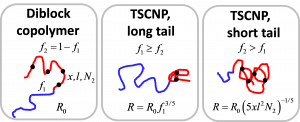STRUCTURE-SIZE RELATIONSHIPS FOR TADPOLE-SHAPED SINGLE-CHAIN NANOPARTICLES UNVEILED
2019 HOT PHYSICAL CHEMISTRY CHEMICAL PHYSICS ARTICLE
A RECENT WORK BY MEMBERS OF THE POLYMERS & SOFT MATTER GROUP HAS BEEN SELECTED BY THE EDITORIAL BOARD OF PHYSICAL CHEMISTRY CHEMICAL PHYSICS (PCCP) AS “2019 HOT PCCP ARTICLE”
In recent years, the construction of polymer-tethered organic nanoparticles has become a new way to obtain totally-soft building blocks for different applications including colloidal and material science, as well as nanotechnology. For nanotechnology applications, polymer-tethered nanoparticles are elemental building blocks to construct advanced self-assembled structures. Among them, the most versatile ones are tadpole-shaped single-chain nanoparticles (TSCNPs) comprising a flexible polymer chain tethered to an intramolecularly folded/collapsed single-chain polymer nanoparticle. A diblock copolymer precursor containing an inert block and a reactive block is often used to synthetize TSCNPs in a good solvent for both blocks at high dilution. However, in spite of significant experimental work, no previous attempts existed to establish structure-size relationships for a priori TSCNP design depending on tail length.

Figure 1: Tadpole-shaped single-chain nanoparticles (TSCNPs) are useful soft building blocks for nanotechnology composed of a flexible polymer chain tethered to an intramolecularly folded single-chain nanoparticle.
A recent PCCP paper by members of the Polymers & Soft Matter Group has disclosed valuable structure-size relationships for a priori TSCNP design depending on tail length. Validation of these relationships by experimental data from multiple TSCNP systems has allowed -for the first time- the prediction of TSCNP size before synthesis, as a function of simple structural parameters of the initially selected block copolymer (see Figure 1). Powerful predictive tools have been, hence, disclosed paving the way to the rational design of TSCNPs as useful, totally-soft building blocks for nanotechnology and other potential applications.
Remarkably, this work has provided with highly original and significant new insight into the physical chemistry of polymer-tethered nanoparticles. Structure-size relationships are very useful to researchers working across different interdisciplinary research areas such as polymers/soft matter, materials, nanoscience/nanotechnology, surfaces/interfaces, etc. As a result, this article has been extremely well received, it has been selected by the Editorial Board as “2019 HOT PCCP article”, announced to the PCCP community and will remain free to access until the end of October 2019.



